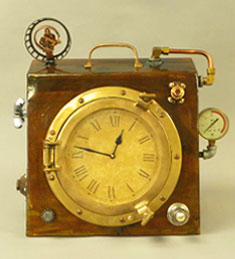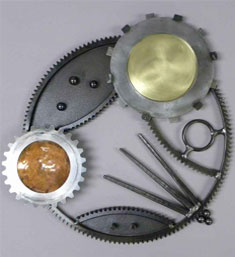Ed Kidera works with old steel cylinders, car, truck and farm parts to create unique pieces for the home and garden that are designed to last a lifetime or two. As of February 2006, he has created 4,300 signed pieces that can be found across the United States and around the world.
Ed began creating unique pieces from old parts at the age of 12. Early projects focused on providing transportation. First, he created a mini-bike from a rototiller and wheelbarrow that was used for many years. A gyrocopter, made from a go-cart was attempted, until the price of blades put an early end to the project. At fourteen, Ed began to create a car from the parts of three different cars, a beer keg, tubing, and fiberglass resin. It took two years to complete and register for the road.
Combining his love for the water and with his early experiences with creativity, Ed studied mechanical engineering at the University of Wisconsin, Parkside. He graduated in just three years and went on to earn a Masters of Science in Ocean Engineering from Florida Atlantic University.
Ed came to Maryland in 1978 for an Engineering position at Johns Hopkins University – Applied Physics Laboratory. While at JHU/APL he invented and designed several motion compensation systems for use with oceanographic instrumentation. He also designed underwater towed vehicles and submarine dye systems. His systems are still in use to this day. In 1982, Ed left the Lab to teach at the US Naval Academy in Annapolis. In 1983, he went out on his own as a consultant.
In the mid-80’s Ed’s interests turned to computer graphics. He created a drawing, animation and hypertext program that was used worldwide on DOS computers. Users could create the art and then produce a hypertext interactive document using the art. Although commonplace today, then it was ahead of its time.
In 1991, Ed combined his background in engineering, his love of art, a pair of old SCUBA tanks from his days as a PADI diving instructor, and his love of the garden into a bell sculpture for the backyard. For Christmas he created a handful of bells for family. Creating hardware was a welcome break from the software, and soon Ed found he could sell his work at local art shows. He was hooked.
By 1993, Ed was working fulltime creating his art from old cylinders and other old pieces. Soon he was making bell stands, mailboxes, bird baths, bird feeders, sculpture, bookends, masks, furniture, lanterns, candle stands, wine buckets, wine racks, teapots, tea cups, and more from recycled steel.
Much of Ed’s work is decorated using the same welding equipment and techniques used to weld the pieces together. He has created hundreds of different designs on the bells, mailboxes and other pieces. Ed uses steel, copper, brass and bronze to “draw” on each piece in a time consuming process that helps ensure that each pieces is unique. Each piece he makes is signed with his initials, the year it was finished, and an identification number. Records are kept on each piece including its size, design, when it was made, when it was sold, and who the proud owner is.
One of Ed’s favorite bell designs is that of the rocker bell. Ed used his background in engineering and motion compensation to create a kinetic sculpture, that once set in motion by a gentle push or the wind, can move continuously for as long as 30 minutes. Some like to refer to these pieces as perpetual motion devices. The rocker bells require perfect balancing to obtain the slow rhythmic motion.
From mini-bikes to garden sculpture, from computer graphics to mailboxes, from motion compensation to rocking bells, Ed has spent his life designing and creating. He puts a little of himself in each original piece he creates.
Functional art to last forever.


